Logistics Management Assignment Solved (Doc)
VerifiedAdded on 2021/02/19
|11
|3209
|27
AI Summary
Contribute Materials
Your contribution can guide someone’s learning journey. Share your
documents today.
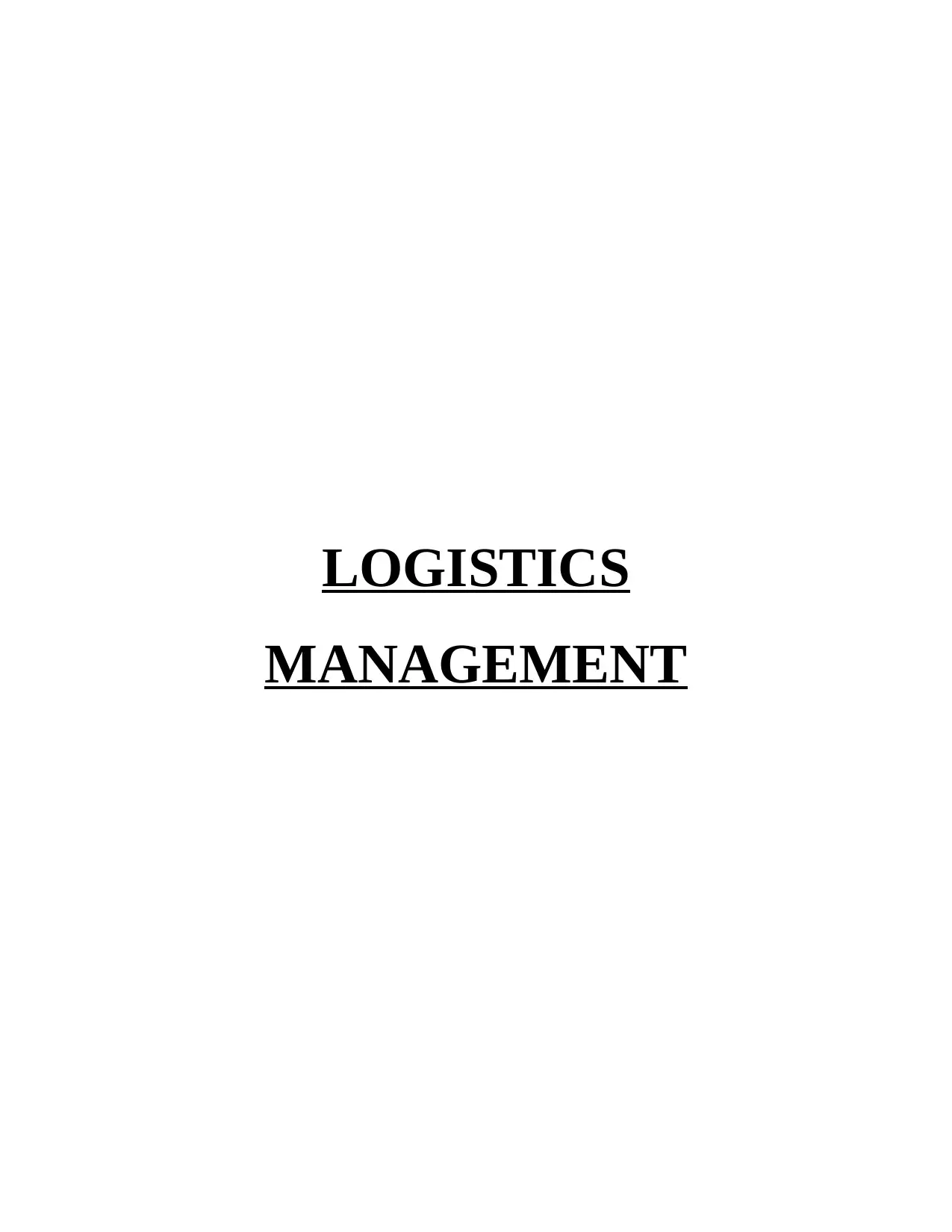
LOGISTICS
MANAGEMENT
MANAGEMENT
Secure Best Marks with AI Grader
Need help grading? Try our AI Grader for instant feedback on your assignments.
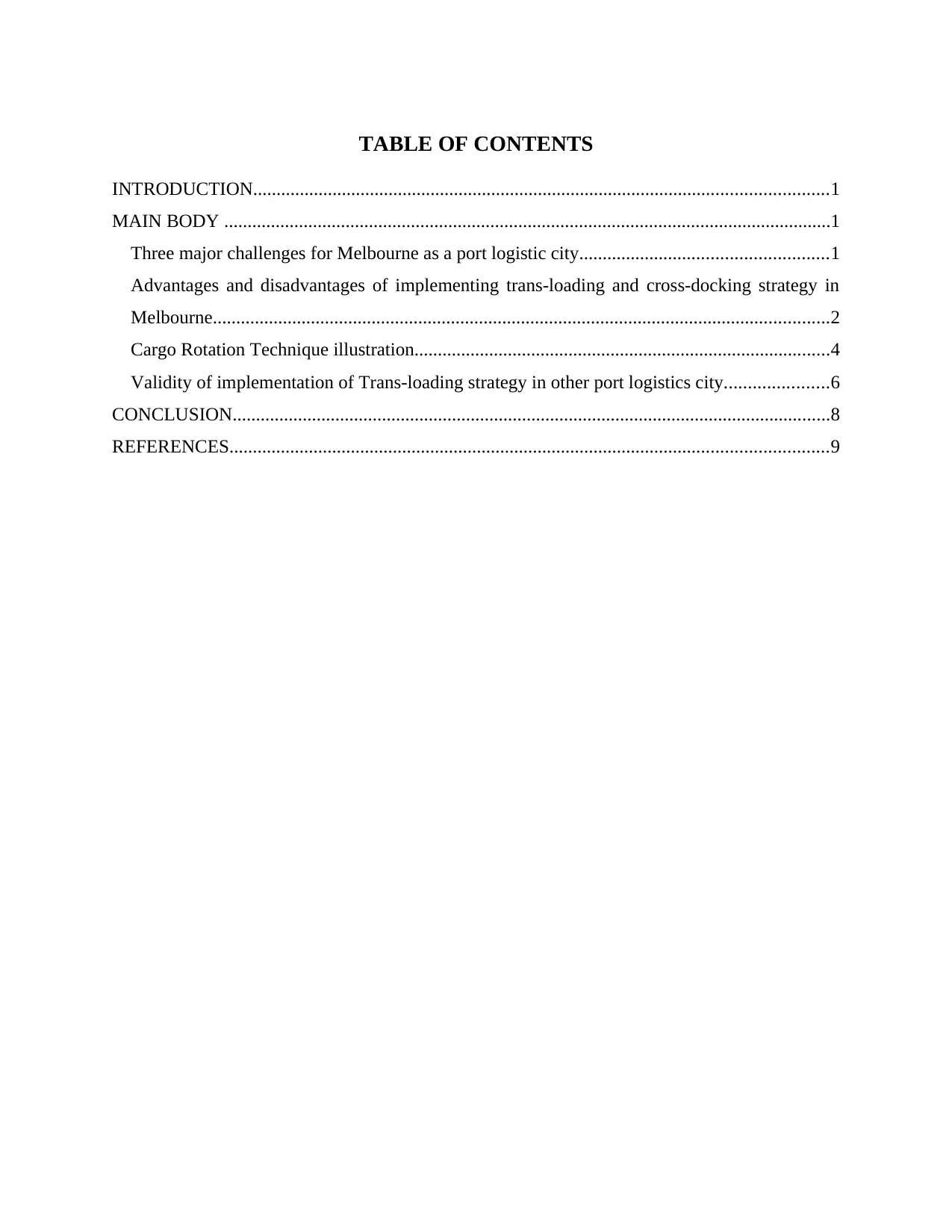
TABLE OF CONTENTS
INTRODUCTION...........................................................................................................................1
MAIN BODY ..................................................................................................................................1
Three major challenges for Melbourne as a port logistic city.....................................................1
Advantages and disadvantages of implementing trans-loading and cross-docking strategy in
Melbourne....................................................................................................................................2
Cargo Rotation Technique illustration.........................................................................................4
Validity of implementation of Trans-loading strategy in other port logistics city......................6
CONCLUSION................................................................................................................................8
REFERENCES................................................................................................................................9
INTRODUCTION...........................................................................................................................1
MAIN BODY ..................................................................................................................................1
Three major challenges for Melbourne as a port logistic city.....................................................1
Advantages and disadvantages of implementing trans-loading and cross-docking strategy in
Melbourne....................................................................................................................................2
Cargo Rotation Technique illustration.........................................................................................4
Validity of implementation of Trans-loading strategy in other port logistics city......................6
CONCLUSION................................................................................................................................8
REFERENCES................................................................................................................................9
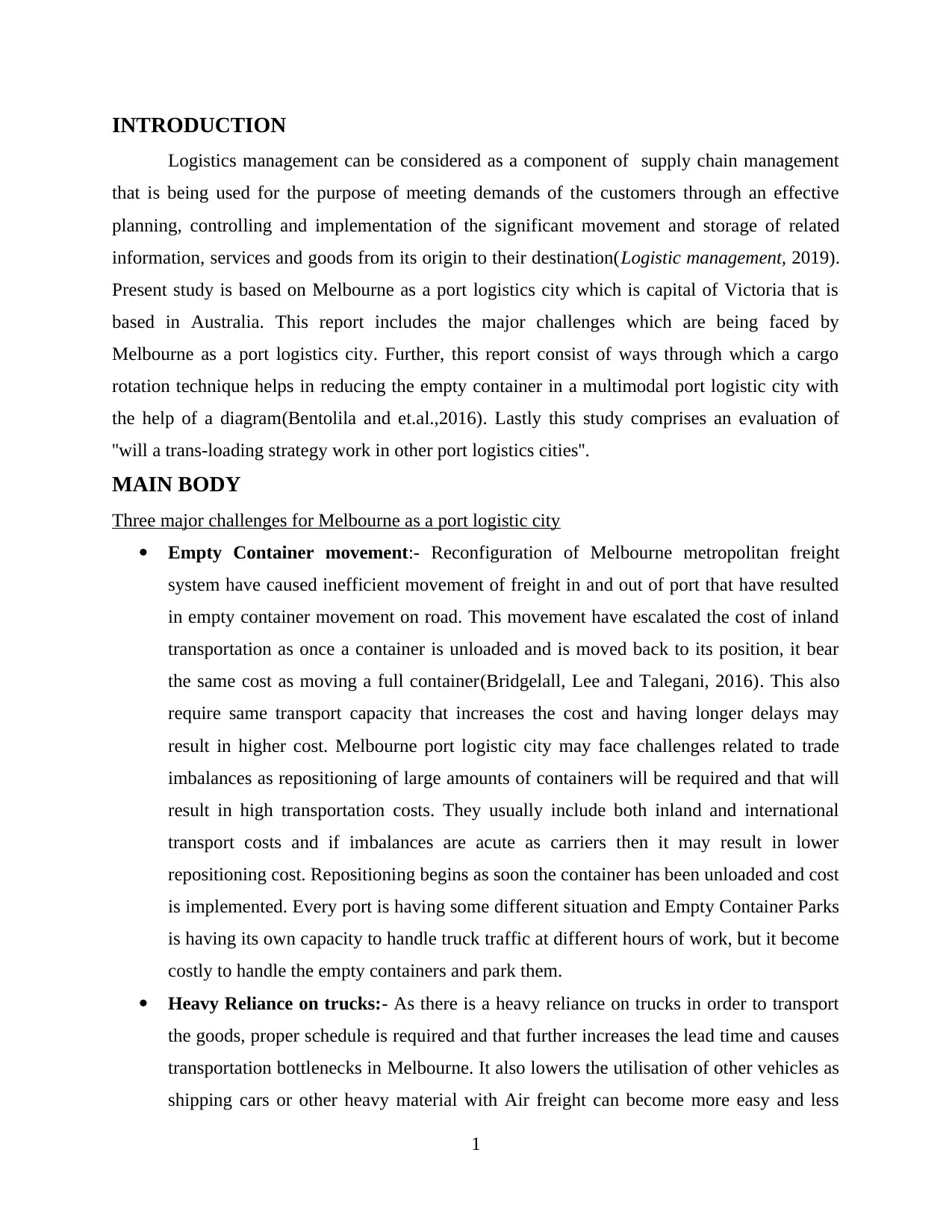
INTRODUCTION
Logistics management can be considered as a component of supply chain management
that is being used for the purpose of meeting demands of the customers through an effective
planning, controlling and implementation of the significant movement and storage of related
information, services and goods from its origin to their destination(Logistic management, 2019).
Present study is based on Melbourne as a port logistics city which is capital of Victoria that is
based in Australia. This report includes the major challenges which are being faced by
Melbourne as a port logistics city. Further, this report consist of ways through which a cargo
rotation technique helps in reducing the empty container in a multimodal port logistic city with
the help of a diagram(Bentolila and et.al.,2016). Lastly this study comprises an evaluation of
''will a trans-loading strategy work in other port logistics cities''.
MAIN BODY
Three major challenges for Melbourne as a port logistic city
Empty Container movement:- Reconfiguration of Melbourne metropolitan freight
system have caused inefficient movement of freight in and out of port that have resulted
in empty container movement on road. This movement have escalated the cost of inland
transportation as once a container is unloaded and is moved back to its position, it bear
the same cost as moving a full container(Bridgelall, Lee and Talegani, 2016). This also
require same transport capacity that increases the cost and having longer delays may
result in higher cost. Melbourne port logistic city may face challenges related to trade
imbalances as repositioning of large amounts of containers will be required and that will
result in high transportation costs. They usually include both inland and international
transport costs and if imbalances are acute as carriers then it may result in lower
repositioning cost. Repositioning begins as soon the container has been unloaded and cost
is implemented. Every port is having some different situation and Empty Container Parks
is having its own capacity to handle truck traffic at different hours of work, but it become
costly to handle the empty containers and park them.
Heavy Reliance on trucks:- As there is a heavy reliance on trucks in order to transport
the goods, proper schedule is required and that further increases the lead time and causes
transportation bottlenecks in Melbourne. It also lowers the utilisation of other vehicles as
shipping cars or other heavy material with Air freight can become more easy and less
1
Logistics management can be considered as a component of supply chain management
that is being used for the purpose of meeting demands of the customers through an effective
planning, controlling and implementation of the significant movement and storage of related
information, services and goods from its origin to their destination(Logistic management, 2019).
Present study is based on Melbourne as a port logistics city which is capital of Victoria that is
based in Australia. This report includes the major challenges which are being faced by
Melbourne as a port logistics city. Further, this report consist of ways through which a cargo
rotation technique helps in reducing the empty container in a multimodal port logistic city with
the help of a diagram(Bentolila and et.al.,2016). Lastly this study comprises an evaluation of
''will a trans-loading strategy work in other port logistics cities''.
MAIN BODY
Three major challenges for Melbourne as a port logistic city
Empty Container movement:- Reconfiguration of Melbourne metropolitan freight
system have caused inefficient movement of freight in and out of port that have resulted
in empty container movement on road. This movement have escalated the cost of inland
transportation as once a container is unloaded and is moved back to its position, it bear
the same cost as moving a full container(Bridgelall, Lee and Talegani, 2016). This also
require same transport capacity that increases the cost and having longer delays may
result in higher cost. Melbourne port logistic city may face challenges related to trade
imbalances as repositioning of large amounts of containers will be required and that will
result in high transportation costs. They usually include both inland and international
transport costs and if imbalances are acute as carriers then it may result in lower
repositioning cost. Repositioning begins as soon the container has been unloaded and cost
is implemented. Every port is having some different situation and Empty Container Parks
is having its own capacity to handle truck traffic at different hours of work, but it become
costly to handle the empty containers and park them.
Heavy Reliance on trucks:- As there is a heavy reliance on trucks in order to transport
the goods, proper schedule is required and that further increases the lead time and causes
transportation bottlenecks in Melbourne. It also lowers the utilisation of other vehicles as
shipping cars or other heavy material with Air freight can become more easy and less
1
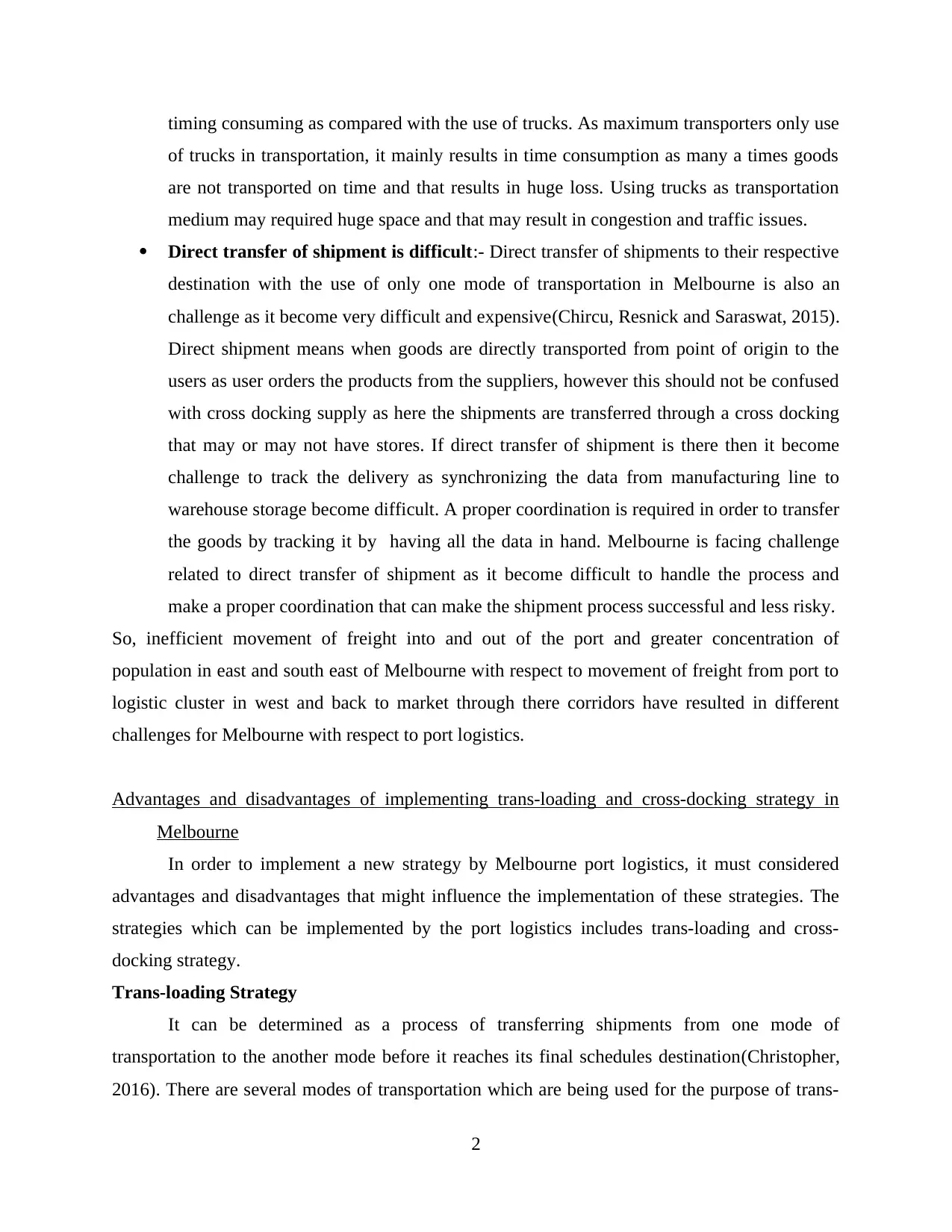
timing consuming as compared with the use of trucks. As maximum transporters only use
of trucks in transportation, it mainly results in time consumption as many a times goods
are not transported on time and that results in huge loss. Using trucks as transportation
medium may required huge space and that may result in congestion and traffic issues.
Direct transfer of shipment is difficult:- Direct transfer of shipments to their respective
destination with the use of only one mode of transportation in Melbourne is also an
challenge as it become very difficult and expensive(Chircu, Resnick and Saraswat, 2015).
Direct shipment means when goods are directly transported from point of origin to the
users as user orders the products from the suppliers, however this should not be confused
with cross docking supply as here the shipments are transferred through a cross docking
that may or may not have stores. If direct transfer of shipment is there then it become
challenge to track the delivery as synchronizing the data from manufacturing line to
warehouse storage become difficult. A proper coordination is required in order to transfer
the goods by tracking it by having all the data in hand. Melbourne is facing challenge
related to direct transfer of shipment as it become difficult to handle the process and
make a proper coordination that can make the shipment process successful and less risky.
So, inefficient movement of freight into and out of the port and greater concentration of
population in east and south east of Melbourne with respect to movement of freight from port to
logistic cluster in west and back to market through there corridors have resulted in different
challenges for Melbourne with respect to port logistics.
Advantages and disadvantages of implementing trans-loading and cross-docking strategy in
Melbourne
In order to implement a new strategy by Melbourne port logistics, it must considered
advantages and disadvantages that might influence the implementation of these strategies. The
strategies which can be implemented by the port logistics includes trans-loading and cross-
docking strategy.
Trans-loading Strategy
It can be determined as a process of transferring shipments from one mode of
transportation to the another mode before it reaches its final schedules destination(Christopher,
2016). There are several modes of transportation which are being used for the purpose of trans-
2
of trucks in transportation, it mainly results in time consumption as many a times goods
are not transported on time and that results in huge loss. Using trucks as transportation
medium may required huge space and that may result in congestion and traffic issues.
Direct transfer of shipment is difficult:- Direct transfer of shipments to their respective
destination with the use of only one mode of transportation in Melbourne is also an
challenge as it become very difficult and expensive(Chircu, Resnick and Saraswat, 2015).
Direct shipment means when goods are directly transported from point of origin to the
users as user orders the products from the suppliers, however this should not be confused
with cross docking supply as here the shipments are transferred through a cross docking
that may or may not have stores. If direct transfer of shipment is there then it become
challenge to track the delivery as synchronizing the data from manufacturing line to
warehouse storage become difficult. A proper coordination is required in order to transfer
the goods by tracking it by having all the data in hand. Melbourne is facing challenge
related to direct transfer of shipment as it become difficult to handle the process and
make a proper coordination that can make the shipment process successful and less risky.
So, inefficient movement of freight into and out of the port and greater concentration of
population in east and south east of Melbourne with respect to movement of freight from port to
logistic cluster in west and back to market through there corridors have resulted in different
challenges for Melbourne with respect to port logistics.
Advantages and disadvantages of implementing trans-loading and cross-docking strategy in
Melbourne
In order to implement a new strategy by Melbourne port logistics, it must considered
advantages and disadvantages that might influence the implementation of these strategies. The
strategies which can be implemented by the port logistics includes trans-loading and cross-
docking strategy.
Trans-loading Strategy
It can be determined as a process of transferring shipments from one mode of
transportation to the another mode before it reaches its final schedules destination(Christopher,
2016). There are several modes of transportation which are being used for the purpose of trans-
2
Secure Best Marks with AI Grader
Need help grading? Try our AI Grader for instant feedback on your assignments.
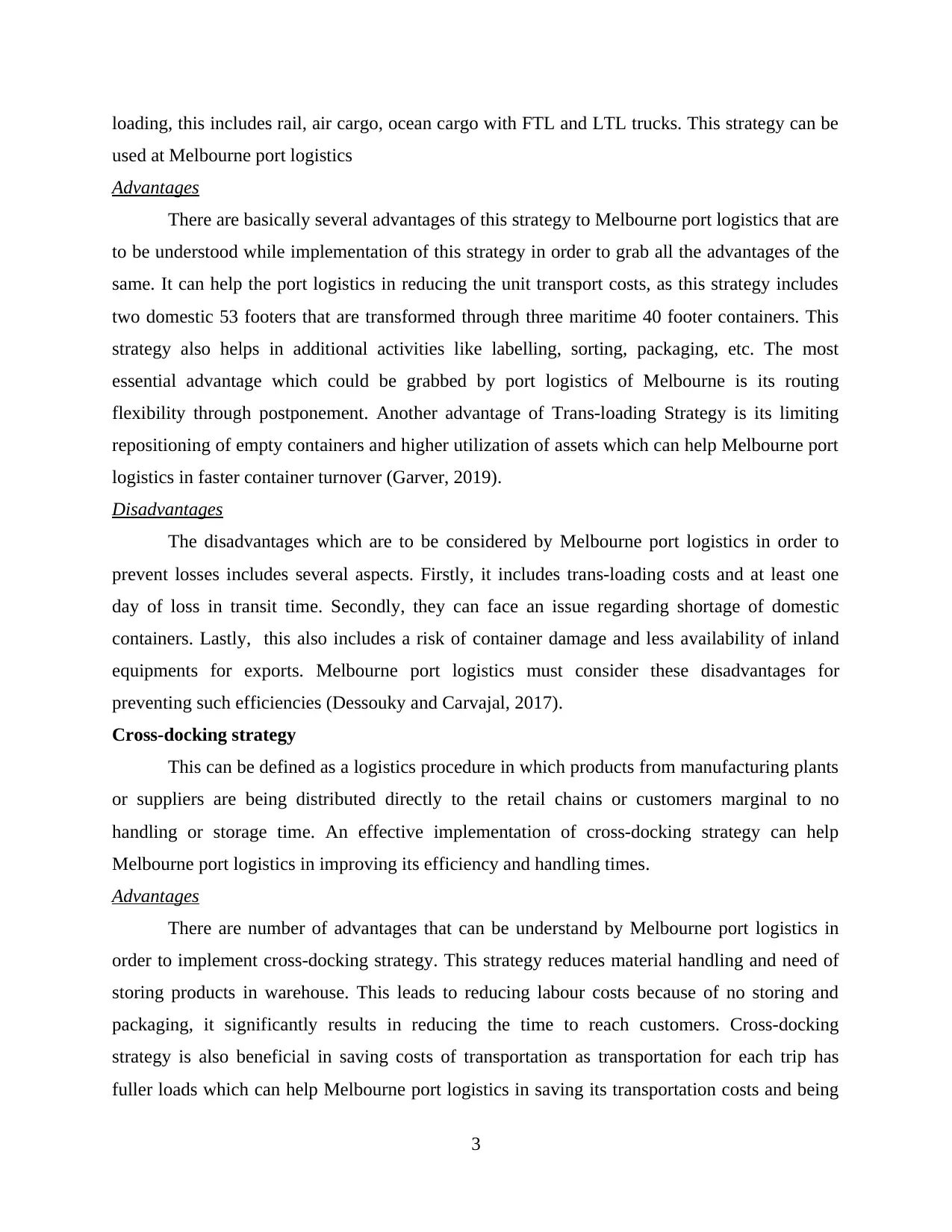
loading, this includes rail, air cargo, ocean cargo with FTL and LTL trucks. This strategy can be
used at Melbourne port logistics
Advantages
There are basically several advantages of this strategy to Melbourne port logistics that are
to be understood while implementation of this strategy in order to grab all the advantages of the
same. It can help the port logistics in reducing the unit transport costs, as this strategy includes
two domestic 53 footers that are transformed through three maritime 40 footer containers. This
strategy also helps in additional activities like labelling, sorting, packaging, etc. The most
essential advantage which could be grabbed by port logistics of Melbourne is its routing
flexibility through postponement. Another advantage of Trans-loading Strategy is its limiting
repositioning of empty containers and higher utilization of assets which can help Melbourne port
logistics in faster container turnover (Garver, 2019).
Disadvantages
The disadvantages which are to be considered by Melbourne port logistics in order to
prevent losses includes several aspects. Firstly, it includes trans-loading costs and at least one
day of loss in transit time. Secondly, they can face an issue regarding shortage of domestic
containers. Lastly, this also includes a risk of container damage and less availability of inland
equipments for exports. Melbourne port logistics must consider these disadvantages for
preventing such efficiencies (Dessouky and Carvajal, 2017).
Cross-docking strategy
This can be defined as a logistics procedure in which products from manufacturing plants
or suppliers are being distributed directly to the retail chains or customers marginal to no
handling or storage time. An effective implementation of cross-docking strategy can help
Melbourne port logistics in improving its efficiency and handling times.
Advantages
There are number of advantages that can be understand by Melbourne port logistics in
order to implement cross-docking strategy. This strategy reduces material handling and need of
storing products in warehouse. This leads to reducing labour costs because of no storing and
packaging, it significantly results in reducing the time to reach customers. Cross-docking
strategy is also beneficial in saving costs of transportation as transportation for each trip has
fuller loads which can help Melbourne port logistics in saving its transportation costs and being
3
used at Melbourne port logistics
Advantages
There are basically several advantages of this strategy to Melbourne port logistics that are
to be understood while implementation of this strategy in order to grab all the advantages of the
same. It can help the port logistics in reducing the unit transport costs, as this strategy includes
two domestic 53 footers that are transformed through three maritime 40 footer containers. This
strategy also helps in additional activities like labelling, sorting, packaging, etc. The most
essential advantage which could be grabbed by port logistics of Melbourne is its routing
flexibility through postponement. Another advantage of Trans-loading Strategy is its limiting
repositioning of empty containers and higher utilization of assets which can help Melbourne port
logistics in faster container turnover (Garver, 2019).
Disadvantages
The disadvantages which are to be considered by Melbourne port logistics in order to
prevent losses includes several aspects. Firstly, it includes trans-loading costs and at least one
day of loss in transit time. Secondly, they can face an issue regarding shortage of domestic
containers. Lastly, this also includes a risk of container damage and less availability of inland
equipments for exports. Melbourne port logistics must consider these disadvantages for
preventing such efficiencies (Dessouky and Carvajal, 2017).
Cross-docking strategy
This can be defined as a logistics procedure in which products from manufacturing plants
or suppliers are being distributed directly to the retail chains or customers marginal to no
handling or storage time. An effective implementation of cross-docking strategy can help
Melbourne port logistics in improving its efficiency and handling times.
Advantages
There are number of advantages that can be understand by Melbourne port logistics in
order to implement cross-docking strategy. This strategy reduces material handling and need of
storing products in warehouse. This leads to reducing labour costs because of no storing and
packaging, it significantly results in reducing the time to reach customers. Cross-docking
strategy is also beneficial in saving costs of transportation as transportation for each trip has
fuller loads which can help Melbourne port logistics in saving its transportation costs and being
3
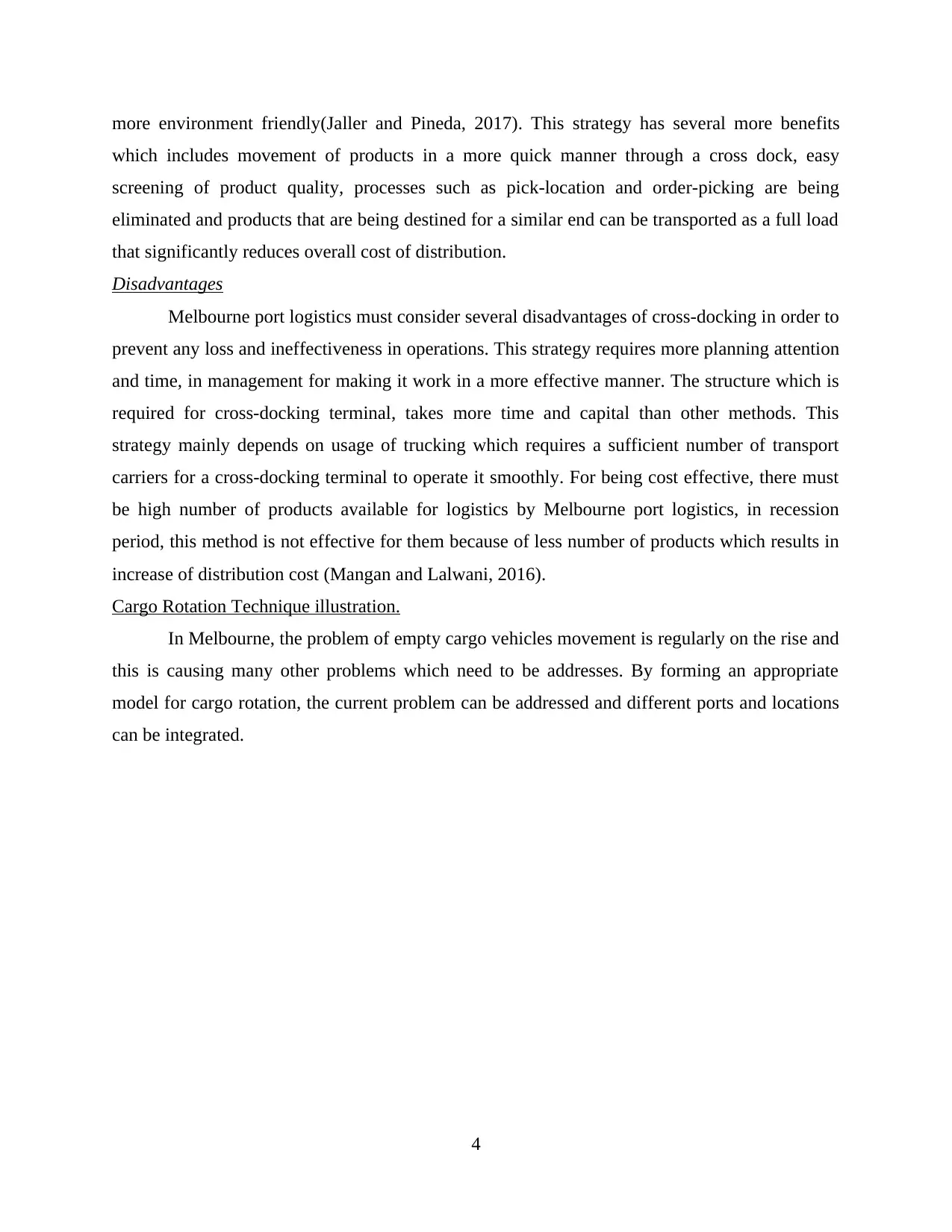
more environment friendly(Jaller and Pineda, 2017). This strategy has several more benefits
which includes movement of products in a more quick manner through a cross dock, easy
screening of product quality, processes such as pick-location and order-picking are being
eliminated and products that are being destined for a similar end can be transported as a full load
that significantly reduces overall cost of distribution.
Disadvantages
Melbourne port logistics must consider several disadvantages of cross-docking in order to
prevent any loss and ineffectiveness in operations. This strategy requires more planning attention
and time, in management for making it work in a more effective manner. The structure which is
required for cross-docking terminal, takes more time and capital than other methods. This
strategy mainly depends on usage of trucking which requires a sufficient number of transport
carriers for a cross-docking terminal to operate it smoothly. For being cost effective, there must
be high number of products available for logistics by Melbourne port logistics, in recession
period, this method is not effective for them because of less number of products which results in
increase of distribution cost (Mangan and Lalwani, 2016).
Cargo Rotation Technique illustration.
In Melbourne, the problem of empty cargo vehicles movement is regularly on the rise and
this is causing many other problems which need to be addresses. By forming an appropriate
model for cargo rotation, the current problem can be addressed and different ports and locations
can be integrated.
4
which includes movement of products in a more quick manner through a cross dock, easy
screening of product quality, processes such as pick-location and order-picking are being
eliminated and products that are being destined for a similar end can be transported as a full load
that significantly reduces overall cost of distribution.
Disadvantages
Melbourne port logistics must consider several disadvantages of cross-docking in order to
prevent any loss and ineffectiveness in operations. This strategy requires more planning attention
and time, in management for making it work in a more effective manner. The structure which is
required for cross-docking terminal, takes more time and capital than other methods. This
strategy mainly depends on usage of trucking which requires a sufficient number of transport
carriers for a cross-docking terminal to operate it smoothly. For being cost effective, there must
be high number of products available for logistics by Melbourne port logistics, in recession
period, this method is not effective for them because of less number of products which results in
increase of distribution cost (Mangan and Lalwani, 2016).
Cargo Rotation Technique illustration.
In Melbourne, the problem of empty cargo vehicles movement is regularly on the rise and
this is causing many other problems which need to be addresses. By forming an appropriate
model for cargo rotation, the current problem can be addressed and different ports and locations
can be integrated.
4
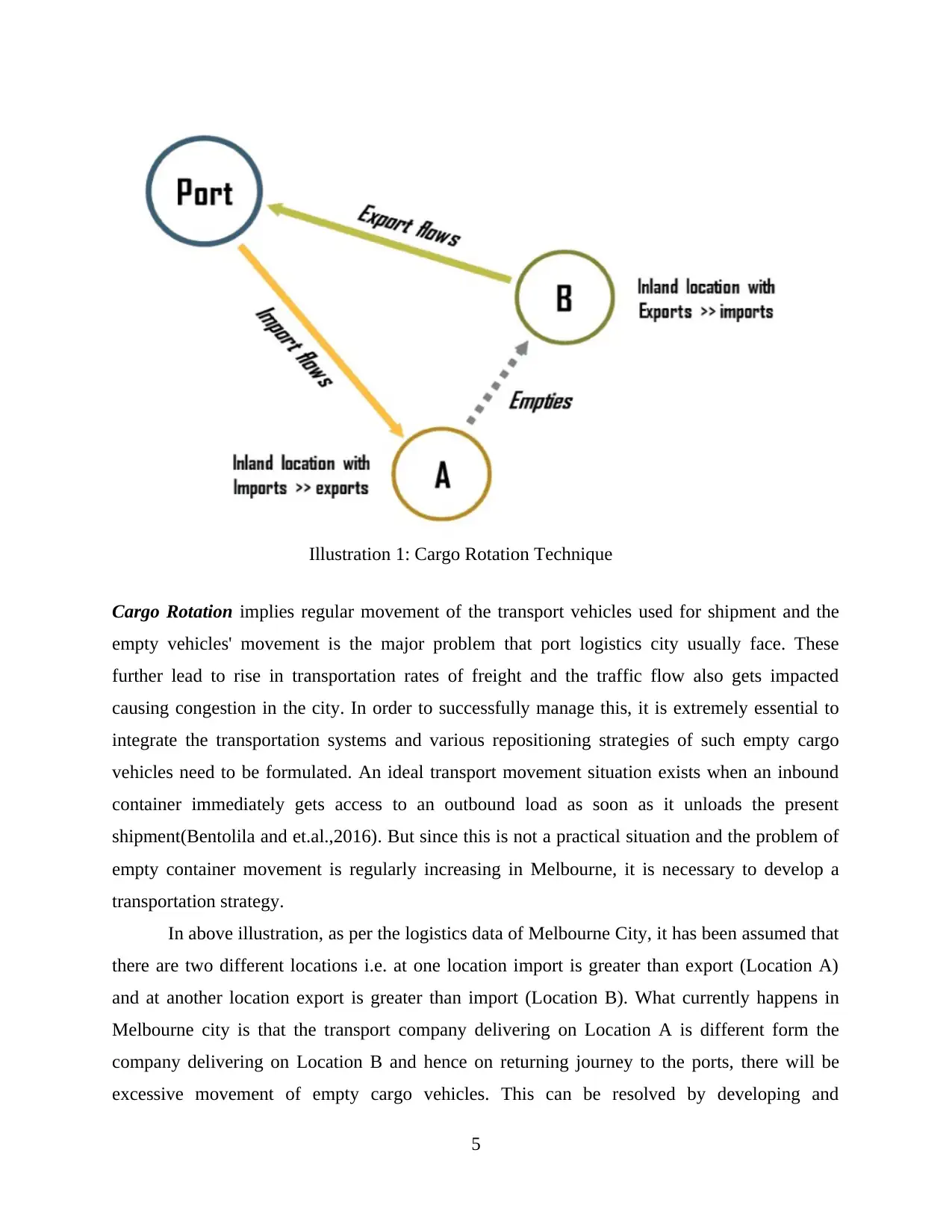
Cargo Rotation implies regular movement of the transport vehicles used for shipment and the
empty vehicles' movement is the major problem that port logistics city usually face. These
further lead to rise in transportation rates of freight and the traffic flow also gets impacted
causing congestion in the city. In order to successfully manage this, it is extremely essential to
integrate the transportation systems and various repositioning strategies of such empty cargo
vehicles need to be formulated. An ideal transport movement situation exists when an inbound
container immediately gets access to an outbound load as soon as it unloads the present
shipment(Bentolila and et.al.,2016). But since this is not a practical situation and the problem of
empty container movement is regularly increasing in Melbourne, it is necessary to develop a
transportation strategy.
In above illustration, as per the logistics data of Melbourne City, it has been assumed that
there are two different locations i.e. at one location import is greater than export (Location A)
and at another location export is greater than import (Location B). What currently happens in
Melbourne city is that the transport company delivering on Location A is different form the
company delivering on Location B and hence on returning journey to the ports, there will be
excessive movement of empty cargo vehicles. This can be resolved by developing and
5
Illustration 1: Cargo Rotation Technique
empty vehicles' movement is the major problem that port logistics city usually face. These
further lead to rise in transportation rates of freight and the traffic flow also gets impacted
causing congestion in the city. In order to successfully manage this, it is extremely essential to
integrate the transportation systems and various repositioning strategies of such empty cargo
vehicles need to be formulated. An ideal transport movement situation exists when an inbound
container immediately gets access to an outbound load as soon as it unloads the present
shipment(Bentolila and et.al.,2016). But since this is not a practical situation and the problem of
empty container movement is regularly increasing in Melbourne, it is necessary to develop a
transportation strategy.
In above illustration, as per the logistics data of Melbourne City, it has been assumed that
there are two different locations i.e. at one location import is greater than export (Location A)
and at another location export is greater than import (Location B). What currently happens in
Melbourne city is that the transport company delivering on Location A is different form the
company delivering on Location B and hence on returning journey to the ports, there will be
excessive movement of empty cargo vehicles. This can be resolved by developing and
5
Illustration 1: Cargo Rotation Technique
Paraphrase This Document
Need a fresh take? Get an instant paraphrase of this document with our AI Paraphraser
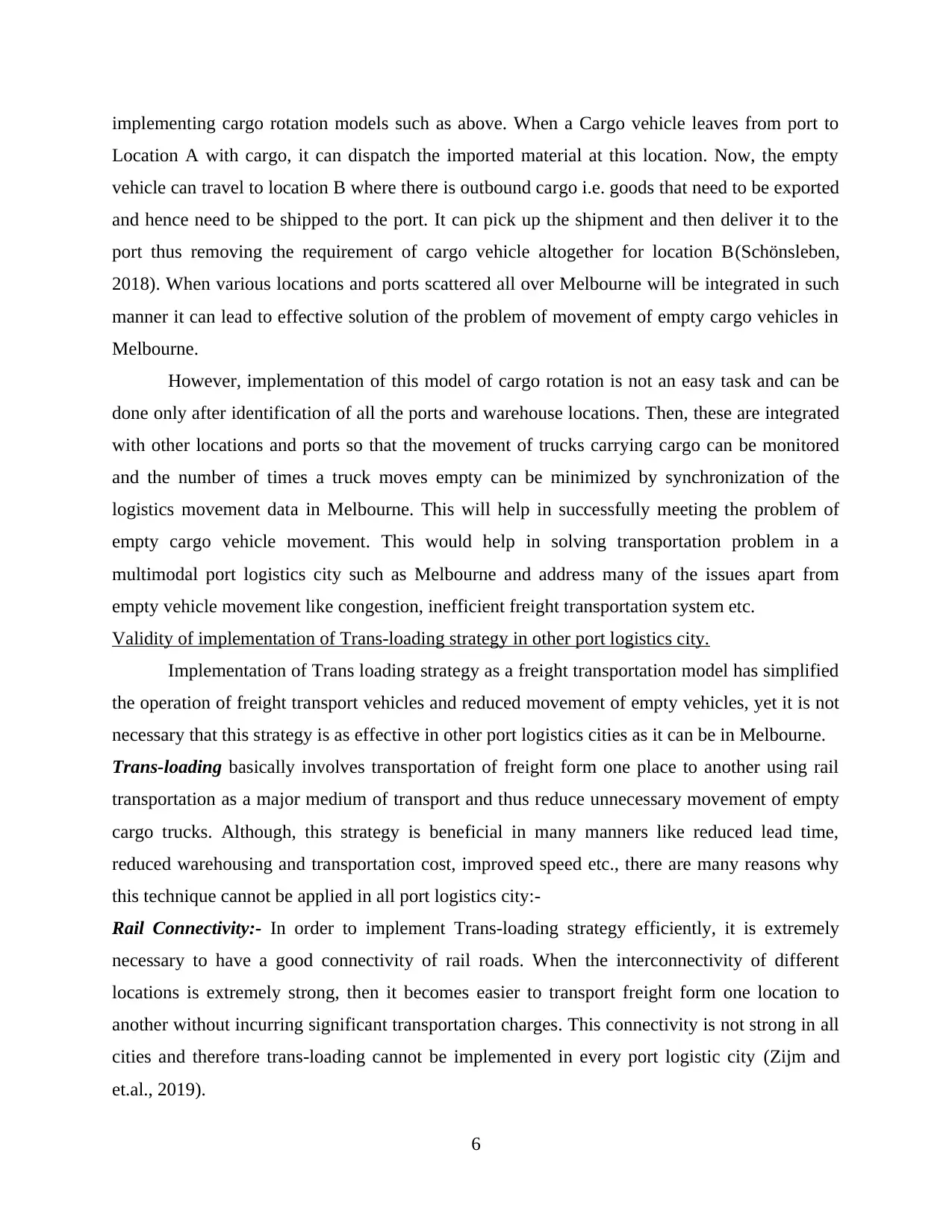
implementing cargo rotation models such as above. When a Cargo vehicle leaves from port to
Location A with cargo, it can dispatch the imported material at this location. Now, the empty
vehicle can travel to location B where there is outbound cargo i.e. goods that need to be exported
and hence need to be shipped to the port. It can pick up the shipment and then deliver it to the
port thus removing the requirement of cargo vehicle altogether for location B(Schönsleben,
2018). When various locations and ports scattered all over Melbourne will be integrated in such
manner it can lead to effective solution of the problem of movement of empty cargo vehicles in
Melbourne.
However, implementation of this model of cargo rotation is not an easy task and can be
done only after identification of all the ports and warehouse locations. Then, these are integrated
with other locations and ports so that the movement of trucks carrying cargo can be monitored
and the number of times a truck moves empty can be minimized by synchronization of the
logistics movement data in Melbourne. This will help in successfully meeting the problem of
empty cargo vehicle movement. This would help in solving transportation problem in a
multimodal port logistics city such as Melbourne and address many of the issues apart from
empty vehicle movement like congestion, inefficient freight transportation system etc.
Validity of implementation of Trans-loading strategy in other port logistics city.
Implementation of Trans loading strategy as a freight transportation model has simplified
the operation of freight transport vehicles and reduced movement of empty vehicles, yet it is not
necessary that this strategy is as effective in other port logistics cities as it can be in Melbourne.
Trans-loading basically involves transportation of freight form one place to another using rail
transportation as a major medium of transport and thus reduce unnecessary movement of empty
cargo trucks. Although, this strategy is beneficial in many manners like reduced lead time,
reduced warehousing and transportation cost, improved speed etc., there are many reasons why
this technique cannot be applied in all port logistics city:-
Rail Connectivity:- In order to implement Trans-loading strategy efficiently, it is extremely
necessary to have a good connectivity of rail roads. When the interconnectivity of different
locations is extremely strong, then it becomes easier to transport freight form one location to
another without incurring significant transportation charges. This connectivity is not strong in all
cities and therefore trans-loading cannot be implemented in every port logistic city (Zijm and
et.al., 2019).
6
Location A with cargo, it can dispatch the imported material at this location. Now, the empty
vehicle can travel to location B where there is outbound cargo i.e. goods that need to be exported
and hence need to be shipped to the port. It can pick up the shipment and then deliver it to the
port thus removing the requirement of cargo vehicle altogether for location B(Schönsleben,
2018). When various locations and ports scattered all over Melbourne will be integrated in such
manner it can lead to effective solution of the problem of movement of empty cargo vehicles in
Melbourne.
However, implementation of this model of cargo rotation is not an easy task and can be
done only after identification of all the ports and warehouse locations. Then, these are integrated
with other locations and ports so that the movement of trucks carrying cargo can be monitored
and the number of times a truck moves empty can be minimized by synchronization of the
logistics movement data in Melbourne. This will help in successfully meeting the problem of
empty cargo vehicle movement. This would help in solving transportation problem in a
multimodal port logistics city such as Melbourne and address many of the issues apart from
empty vehicle movement like congestion, inefficient freight transportation system etc.
Validity of implementation of Trans-loading strategy in other port logistics city.
Implementation of Trans loading strategy as a freight transportation model has simplified
the operation of freight transport vehicles and reduced movement of empty vehicles, yet it is not
necessary that this strategy is as effective in other port logistics cities as it can be in Melbourne.
Trans-loading basically involves transportation of freight form one place to another using rail
transportation as a major medium of transport and thus reduce unnecessary movement of empty
cargo trucks. Although, this strategy is beneficial in many manners like reduced lead time,
reduced warehousing and transportation cost, improved speed etc., there are many reasons why
this technique cannot be applied in all port logistics city:-
Rail Connectivity:- In order to implement Trans-loading strategy efficiently, it is extremely
necessary to have a good connectivity of rail roads. When the interconnectivity of different
locations is extremely strong, then it becomes easier to transport freight form one location to
another without incurring significant transportation charges. This connectivity is not strong in all
cities and therefore trans-loading cannot be implemented in every port logistic city (Zijm and
et.al., 2019).
6
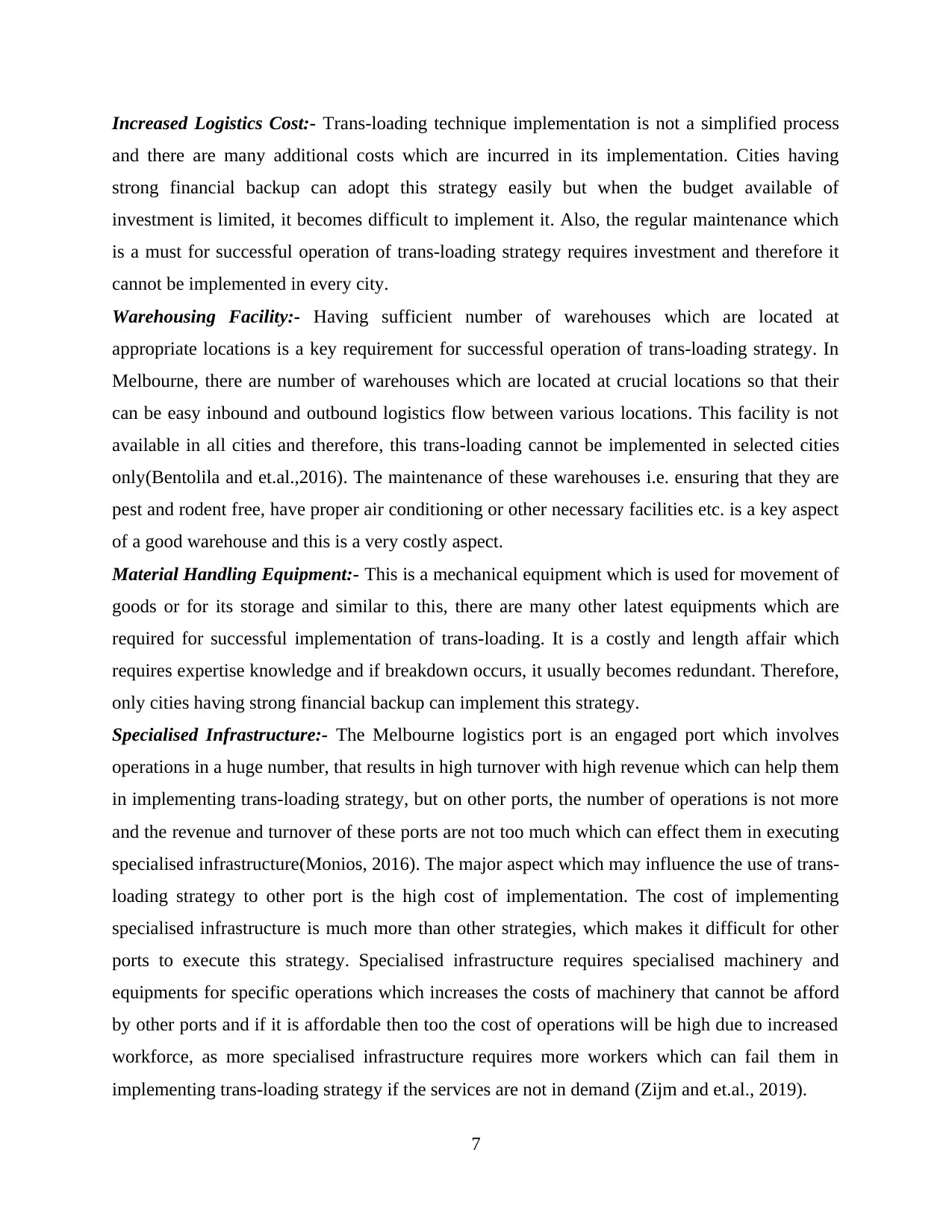
Increased Logistics Cost:- Trans-loading technique implementation is not a simplified process
and there are many additional costs which are incurred in its implementation. Cities having
strong financial backup can adopt this strategy easily but when the budget available of
investment is limited, it becomes difficult to implement it. Also, the regular maintenance which
is a must for successful operation of trans-loading strategy requires investment and therefore it
cannot be implemented in every city.
Warehousing Facility:- Having sufficient number of warehouses which are located at
appropriate locations is a key requirement for successful operation of trans-loading strategy. In
Melbourne, there are number of warehouses which are located at crucial locations so that their
can be easy inbound and outbound logistics flow between various locations. This facility is not
available in all cities and therefore, this trans-loading cannot be implemented in selected cities
only(Bentolila and et.al.,2016). The maintenance of these warehouses i.e. ensuring that they are
pest and rodent free, have proper air conditioning or other necessary facilities etc. is a key aspect
of a good warehouse and this is a very costly aspect.
Material Handling Equipment:- This is a mechanical equipment which is used for movement of
goods or for its storage and similar to this, there are many other latest equipments which are
required for successful implementation of trans-loading. It is a costly and length affair which
requires expertise knowledge and if breakdown occurs, it usually becomes redundant. Therefore,
only cities having strong financial backup can implement this strategy.
Specialised Infrastructure:- The Melbourne logistics port is an engaged port which involves
operations in a huge number, that results in high turnover with high revenue which can help them
in implementing trans-loading strategy, but on other ports, the number of operations is not more
and the revenue and turnover of these ports are not too much which can effect them in executing
specialised infrastructure(Monios, 2016). The major aspect which may influence the use of trans-
loading strategy to other port is the high cost of implementation. The cost of implementing
specialised infrastructure is much more than other strategies, which makes it difficult for other
ports to execute this strategy. Specialised infrastructure requires specialised machinery and
equipments for specific operations which increases the costs of machinery that cannot be afford
by other ports and if it is affordable then too the cost of operations will be high due to increased
workforce, as more specialised infrastructure requires more workers which can fail them in
implementing trans-loading strategy if the services are not in demand (Zijm and et.al., 2019).
7
and there are many additional costs which are incurred in its implementation. Cities having
strong financial backup can adopt this strategy easily but when the budget available of
investment is limited, it becomes difficult to implement it. Also, the regular maintenance which
is a must for successful operation of trans-loading strategy requires investment and therefore it
cannot be implemented in every city.
Warehousing Facility:- Having sufficient number of warehouses which are located at
appropriate locations is a key requirement for successful operation of trans-loading strategy. In
Melbourne, there are number of warehouses which are located at crucial locations so that their
can be easy inbound and outbound logistics flow between various locations. This facility is not
available in all cities and therefore, this trans-loading cannot be implemented in selected cities
only(Bentolila and et.al.,2016). The maintenance of these warehouses i.e. ensuring that they are
pest and rodent free, have proper air conditioning or other necessary facilities etc. is a key aspect
of a good warehouse and this is a very costly aspect.
Material Handling Equipment:- This is a mechanical equipment which is used for movement of
goods or for its storage and similar to this, there are many other latest equipments which are
required for successful implementation of trans-loading. It is a costly and length affair which
requires expertise knowledge and if breakdown occurs, it usually becomes redundant. Therefore,
only cities having strong financial backup can implement this strategy.
Specialised Infrastructure:- The Melbourne logistics port is an engaged port which involves
operations in a huge number, that results in high turnover with high revenue which can help them
in implementing trans-loading strategy, but on other ports, the number of operations is not more
and the revenue and turnover of these ports are not too much which can effect them in executing
specialised infrastructure(Monios, 2016). The major aspect which may influence the use of trans-
loading strategy to other port is the high cost of implementation. The cost of implementing
specialised infrastructure is much more than other strategies, which makes it difficult for other
ports to execute this strategy. Specialised infrastructure requires specialised machinery and
equipments for specific operations which increases the costs of machinery that cannot be afford
by other ports and if it is affordable then too the cost of operations will be high due to increased
workforce, as more specialised infrastructure requires more workers which can fail them in
implementing trans-loading strategy if the services are not in demand (Zijm and et.al., 2019).
7

CONCLUSION
From the present study, it can be concluded that logistics management helps in creating
and increasing the value of businesses through improving merchandise with ensuring the
availability of products. This report concludes that there are majorly three challenges that might
be faced by Melbourne port logistics consist of empty container movement, heavy reliance on
trucks and difficulty in direct transfer of shipment. Further this report concludes that there are
several advantages and disadvantages of trans-loading and cross-docking strategy which are
essential to understand by Melbourne port logistics in order to implement these strategies in a
more significant manner.
8
From the present study, it can be concluded that logistics management helps in creating
and increasing the value of businesses through improving merchandise with ensuring the
availability of products. This report concludes that there are majorly three challenges that might
be faced by Melbourne port logistics consist of empty container movement, heavy reliance on
trucks and difficulty in direct transfer of shipment. Further this report concludes that there are
several advantages and disadvantages of trans-loading and cross-docking strategy which are
essential to understand by Melbourne port logistics in order to implement these strategies in a
more significant manner.
8
Secure Best Marks with AI Grader
Need help grading? Try our AI Grader for instant feedback on your assignments.

REFERENCES
Books and Journals
Bentolila, D.J. And et.al., 2016. Off-peak truck deliveries at container terminals: the “Good
Night” program in Israel. Maritime Business Review. 1(1). pp.2-20.
Bridgelall, R., Lee, E. and Talegani, A.R., 2016. Sourcing Strategy for Asphalt Production
Feedstock Considering Multimodal Transport Options.
Chircu, A.M., Resnick, M. and Saraswat, S.P., 2015. Online Intermediaries and Supply Chains.
The International Encyclopedia of Digital Communication and Society, pp.1-13.
Christopher, M., 2016. Logistics & supply chain management. Pearson UK.
Dessouky, M. and Carvajal, S., 2017. Congestion Reduction Through Efficient Empty Container
Movement.
Garver, M.S., 2019. Threats to the Validity of Logistics and Supply Chain Management
Research. Journal of Business Logistics. 40(1). pp.30-43.
Jaller, M. and Pineda, L., 2017. Warehousing and Distribution Center Facilities in Southern
California: The Use of the Commodity Flow Survey Data to Identify Logistics Sprawl and
Freight Generation Patterns.
Mangan, J. and Lalwani, C.L., 2016. Global logistics and supply chain management. John Wiley
& Sons.
Monios, J., 2016. Institutional challenges to intermodal transport and logistics: governance in
port regionalisation and hinterland integration. Routledge.
Schönsleben, P., 2018. Integral logistics management: operations and supply chain management
within and across companies. CRC Press.
Zijm, H. and et.al., 2019. Operations, Logistics and Supply Chain Management: Definitions and
Objectives. In Operations, Logistics and Supply Chain Management (pp. 27-42). Springer,
Cham.
Zijm, H. and et.al., 2019. Operations, Logistics and Supply Chain Management. Springer.
Online
Logistic management. 2019. [ONLINE]. Available.
Through<https://www.techopedia.com/definition/13984/logistics-management>
9
Books and Journals
Bentolila, D.J. And et.al., 2016. Off-peak truck deliveries at container terminals: the “Good
Night” program in Israel. Maritime Business Review. 1(1). pp.2-20.
Bridgelall, R., Lee, E. and Talegani, A.R., 2016. Sourcing Strategy for Asphalt Production
Feedstock Considering Multimodal Transport Options.
Chircu, A.M., Resnick, M. and Saraswat, S.P., 2015. Online Intermediaries and Supply Chains.
The International Encyclopedia of Digital Communication and Society, pp.1-13.
Christopher, M., 2016. Logistics & supply chain management. Pearson UK.
Dessouky, M. and Carvajal, S., 2017. Congestion Reduction Through Efficient Empty Container
Movement.
Garver, M.S., 2019. Threats to the Validity of Logistics and Supply Chain Management
Research. Journal of Business Logistics. 40(1). pp.30-43.
Jaller, M. and Pineda, L., 2017. Warehousing and Distribution Center Facilities in Southern
California: The Use of the Commodity Flow Survey Data to Identify Logistics Sprawl and
Freight Generation Patterns.
Mangan, J. and Lalwani, C.L., 2016. Global logistics and supply chain management. John Wiley
& Sons.
Monios, J., 2016. Institutional challenges to intermodal transport and logistics: governance in
port regionalisation and hinterland integration. Routledge.
Schönsleben, P., 2018. Integral logistics management: operations and supply chain management
within and across companies. CRC Press.
Zijm, H. and et.al., 2019. Operations, Logistics and Supply Chain Management: Definitions and
Objectives. In Operations, Logistics and Supply Chain Management (pp. 27-42). Springer,
Cham.
Zijm, H. and et.al., 2019. Operations, Logistics and Supply Chain Management. Springer.
Online
Logistic management. 2019. [ONLINE]. Available.
Through<https://www.techopedia.com/definition/13984/logistics-management>
9
1 out of 11
Related Documents
Your All-in-One AI-Powered Toolkit for Academic Success.
+13062052269
info@desklib.com
Available 24*7 on WhatsApp / Email
![[object Object]](/_next/static/media/star-bottom.7253800d.svg)
Unlock your academic potential
© 2024 | Zucol Services PVT LTD | All rights reserved.





